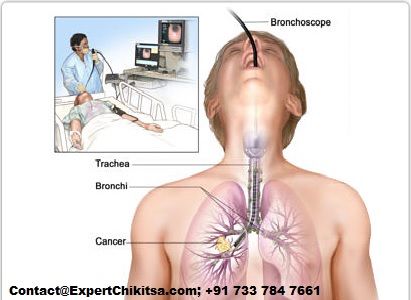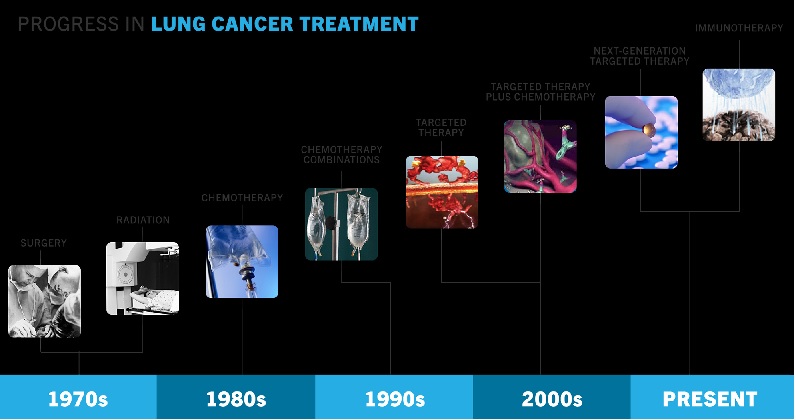Lung Cancer Treatment in India
Lung Cancer Treatment, Best Doctor and Hospitals for Lung Cancer Treatment, Cost for Lung Cancer Treatment, Lung Cancer Chemotherapy, Surgery and Radiation Therapy
Lung Cancer is an uncontrollable growth of cells that begins in the lungs and later spreads to the other parts of the body. These abnormal cells grow and interfere with the functioning of the lung, which provides oxygen to the body. Lung cancer is the major cause of deaths among both men and women. But lung cancer treatment in India is possible with advanced and improved therapy – Cancer Healer Center – by one of the leading cancer clinics, Cancer Healer Center.
Lung Cancer Sign & Symptoms:
The signs and symptoms of lung cancer can take years to develop and may not appear untill the disease is advanced. Symptoms of lung cancer include:
Coughing up Blood
Chest Pain
Weight loss and general fatigue
Loss of Appetite Shortness of breath and change in the voice.
Contact us for Lung Cancer Medical Second Opinion
Treatment Plan,Cost Estimate and Tele-Consultation from Top Lung Cancer Surgeons and Leading Cancer Hospitals.
Email: Contact@ExpertChikitsa.com
Phone: +91 9620350205

How Lung Cancer is Diagnosed?
If lung cancer is suspected as a result of a screening procedure, a small piece of tissue from the lung is Examined under a microscope to look for cancer cells. Later the following tests are done to confirm the presence of cancer cells
- Lung Biopsy: When a tumor is found in the lungs, this test is done to evaluate the type of abnormal cells.
- Bronchoscopy: This test diagnoses and determines the extent of lung cancer.
- A CT scan, liver ultrasound or bone scan is done to find out if the cancer has spread to the other parts of the body.
Causes of Lung Cancer
Smoking: Tobacco and Smoking is the number one risk factor for lung cancer. Quitting at any age can significantly lower your risk of developing lung cancer.
Second-hand Smoke: Smoke from other people’s cigarettes, pipes, or cigars also causes lung cancer.
Exposure to asbestos and other harmful chemicals: The other main causes of lung cancer are breathing industrial chemicals such as asbestos, arsenic and polycyclic
Main types of Lung Cancer include:
Small Cell Lung Cancer:
This type of cancer spreads quickly. It is also called oat cell cancer. About 10%-15% of cancers are of this type.
Non-Small Cell Lung Cancer:
It is one of the most common types of cancer. About 85% of lung cancers are of this type. Subtypes of non-small lung cancer include Squamous cell carcinoma, adenocarcinoma, and large cell carcinoma.
Lung Carcinoid Tumor:
It is also called lung neuroendocrine tumors. About 5% of lung cancers are of this type. They grow slowly and rarely spread.
Know More:
Best Lung Cancer Hospitals in India.
Lung Cancer Treatment:
Surgery, radiation, chemotherapy, targeted treatments and Immunotherapy—alone or in combination—are used to treat lung cancer. Each of these types of treatments may cause different side effects.
Surgery
Most stage I and stage II non-small cell lung cancers are treated with surgery to remove the tumor. For this procedure, a surgeon removes the lobe, or section, of the lung containing the tumor.
Some surgeons use video-assisted thoracoscopic surgery (VATS). For this procedure, the surgeon makes a small incision, or cut, in the chest and inserts a tube called a thoracoscope. The thoracoscope has a light and a tiny camera connected to a video monitor so that the surgeon can see inside the chest. A lung lobe can then be removed through the scope, without making a large incision in the chest.
Chemotherapy and Radiation
For people with non-small cell lung tumors that can be surgically removed, evidence suggests that chemotherapy after surgery, known as “adjuvant chemotherapy,” may help prevent the cancer from returning. This is particularly true for patients with stage II and IIIA disease. Questions remain about whether adjuvant chemotherapy applies to other patients and how much they benefit.
For people with stage III lung cancer that cannot be removed surgically, doctors typically recommend chemotherapy in combination with definitive (high-dose) radiation treatments. In stage IV lung cancer, chemotherapy is typically the main treatment. In stage IV patients, radiation is used only for palliation of symptoms.
The chemotherapy treatment plan for lung cancer often consists of a combination of drugs. Among the drugs most commonly used are cisplatin (Platinol) or carboplatin (Paraplatin) plus docetaxel (Taxotere), gemcitabine (Gemzar), paclitaxel (Taxol and others), vinorelbine (Navelbine and others), or pemetrexed (Alimta).
Immunotherapy
Immunotherapy has recently emerged as a new treatment option for certain lung cancers. While any cancer treatment can cause side effects, immunotherapy is generally well-tolerated; this is in part due to its mechanism of action.
Our immune system is constantly working to keep us healthy. It recognizes and fights against danger, such as infections, viruses, and growing cancer cells. In general terms, immunotherapy uses our own immune system as a treatment against cancer.
Home Care for Lung Cancer
If you’ve had lung surgery, a nurse or doctor can show you special exercises to improve breathing and strengthen chest muscles. You can relieve skin irritation associated with radiation therapy by wearing loose clothes and keeping your chest protected from the sun. Avoid using skin lotions unless approved by your doctor.
FOR MORE INFORMATION ON BEST DOCTOR & HOSPITAL, TREATMENT PLAN, COST , TELE-CONSULTATION AND SECOND OPINION CONTACT US,
Phone Numbers: +91 9620350205
Mail Id: Contact@Expertchikitsa.com
Facebook: https://www.facebook.com/ExpertChikitsa
Website: https://www.expertchikitsa.com/




